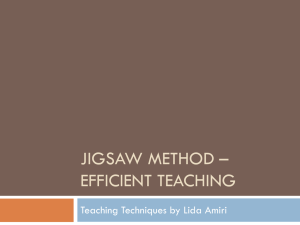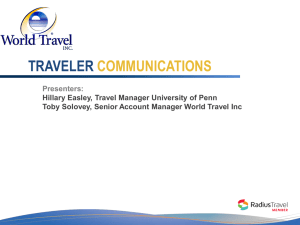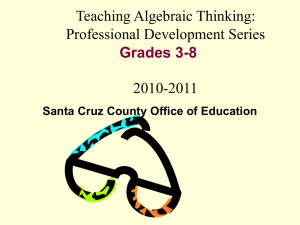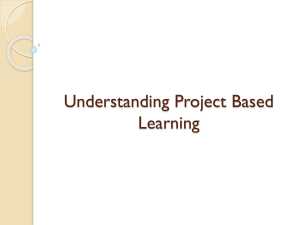Read, Write, Think lesson plan
advertisement
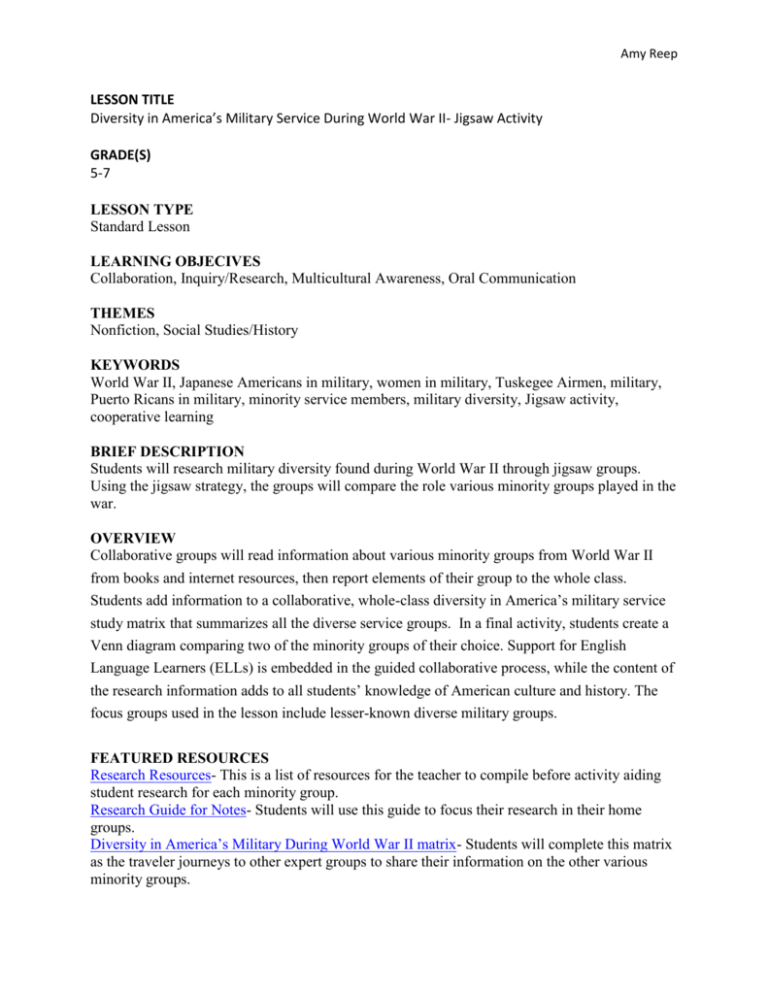
Amy Reep LESSON TITLE Diversity in America’s Military Service During World War II- Jigsaw Activity GRADE(S) 5-7 LESSON TYPE Standard Lesson LEARNING OBJECIVES Collaboration, Inquiry/Research, Multicultural Awareness, Oral Communication THEMES Nonfiction, Social Studies/History KEYWORDS World War II, Japanese Americans in military, women in military, Tuskegee Airmen, military, Puerto Ricans in military, minority service members, military diversity, Jigsaw activity, cooperative learning BRIEF DESCRIPTION Students will research military diversity found during World War II through jigsaw groups. Using the jigsaw strategy, the groups will compare the role various minority groups played in the war. OVERVIEW Collaborative groups will read information about various minority groups from World War II from books and internet resources, then report elements of their group to the whole class. Students add information to a collaborative, whole-class diversity in America’s military service study matrix that summarizes all the diverse service groups. In a final activity, students create a Venn diagram comparing two of the minority groups of their choice. Support for English Language Learners (ELLs) is embedded in the guided collaborative process, while the content of the research information adds to all students’ knowledge of American culture and history. The focus groups used in the lesson include lesser-known diverse military groups. FEATURED RESOURCES Research Resources- This is a list of resources for the teacher to compile before activity aiding student research for each minority group. Research Guide for Notes- Students will use this guide to focus their research in their home groups. Diversity in America’s Military During World War II matrix- Students will complete this matrix as the traveler journeys to other expert groups to share their information on the other various minority groups. Amy Reep Group Discussion Worksheet- A Planning tool that the groups will refer to in order to help focus and distribute research jobs to individual members of the group. Self Assessment- Students will reflect and access their participation in the collaborative jigsaw process. FROM THEORY TO PRACTICE Glasswell, K., & Ford, M. P. (2010). Teaching Flexibly With Leveled Texts: More Power for Your Reading Block. Reading Teacher, 64(1), 57-60. doi:10.1598/RT.64.1.7 The authors suggest that reading teachers can be flexible with assigning books of different reading levels in order to promote reading development in below-level readers. The article describes how reading teachers can use leveled reading in various types reading. Teachers are encouraged to provide a variety of texts with varying difficulty, use individualized instructional formats, and integrate the use of alternative texts. In this collaborative group lesson, a modified jigsaw technique, with various leveled texts, is used in a reading lesson in which students compare diverse minority groups during World War II. STANDARDS 1. Students read a wide range of print and nonprint texts to build an understanding of texts, of themselves, and of the cultures of the United States and the world; to acquire new information; to respond to the needs and demands of society and the workplace; and for personal fulfillment. Among these texts are fiction and nonfiction, classic and contemporary works. 4. Students adjust their use of spoken, written, and visual language (e.g., conventions, style, vocabulary) to communicate effectively with a variety of audiences and for different purposes. 7. Students conduct research on issues and interests by generating ideas and questions, and by posing problems. They gather, evaluate, and synthesize data from a variety of sources (e.g., print and nonprint texts, artifacts, people) to communicate their discoveries in ways that suit their purpose and audience. 8. Students use a variety of technological and information resources (e.g., libraries, databases, computer networks, video) to gather and synthesize information and to create and communicate knowledge. RESOURCES Materials and Technology Teacher should locate materials (books and internet articles if computer/internet not available) for student research before groups (see Research Resources) Computers or Computer Lab with Internet Access and Photo Story program(extension activity) Amy Reep Interactives Venn Diagram comparison-Venn Diagram, 2 circles - ReadWriteThink http://www.readwritethink.org/files/resources/interactives/venn/ T-Chart discussion during whole grouphttp://www.readwritethink.org/files/resources/printouts/T-Chart.pdf Printouts Copies for each student of matrix (Diversity in America’s Military During World War II matrix)- This matrix is used for whole-class discussion and group study. Copies for each student of research guide (Research guide for Note Taking)- Students use this worksheet within their groups to plan and understand their roles. Copies for each group of group discussion worksheet ( Group Discussion Worksheet) Copies for each student of group self assessment- (Self-Assessment) ESTIMATED LESSON TIME Seven 50-minute sessions STUDENT OBJECTIVES Students will read and discuss non-fiction informational texts, with particular focus on diversity, details, and settings. work in collaborative groups to summarize key points and characteristics of specific groups. work in collaborative groups to post research information onto a multi-group matrix. Compare and contrast two groups of diverse populations using details. assess their own participation in the collaborative process. PREPARATION 1. Gather books that reflect diversity in military during World War II, using the Research Resource list or by downloading and printing stories from websites like those on the Research Resource list. The selection of non-fiction books and articles should be chosen to enhance student reading. It should be varied according to reading levels within the group. You will need enough copies of each selected story for each person in each group. Each group will read about a different group of military members. 2. Prepare the Diversity in America’s Military during World War II matrix. One can be done for whole class using large butcher paper as example. Label the columns across the top as follows: Amy Reep Title (Left-hand vertical cells, under Group Title. Note: If possible, make the whole-class group study matrix example is large enough so that each cell is the size of a regular sheet of copy paper.) Left row going down should be the name of the diverse military group each collaborative group will research. Top columns should be labeled with required research material groups are reporting on: Members of the Group Jobs during World War II Differences from other soldiers Why this group is important to remember 3. 4. Create heterogeneous, collaborative student groups with five members in each group. Make copies of the Jigsaw Research Guide for Note Taking and Jigsaw Group SelfAssessment sheet, one copy for each student. 5. Bookmark the Interactive Venn Diagram. 6. Bookmark the pdf of T-Chart. SESSION ONE 1. Post the prepared whole class example of Diverse in America’s Military during World War II matrix in view of all students. 2. Read aloud a picture book about a group of citizens that helped out during World War II. I suggest John F. Kennedy and PT109 (ASurvivor) by Philip Abraham, but it is your choice. Just make sure that it will not be read by any of the student groups. To model what students will do in their groups, discuss the story by asking the following questions, referring to the related columns on the whole class example matrix as you ask the questions: Who is this group of people? What was their job during World War II? Where were they stationed? How were they important to the war effort? Why are they a usually forgotten part? Describe one famous participant from this group. Amy Reep Two other important details about this group: How can you compare this group/person with any other character(s) you’ve read about recently? What other comments do you have about this story? 3. After the discussion, inform students that they will be working in groups using a special strategy called a Jigsaw, where everyone in the group will read a story about the same group and each person in the group will be responsible for reporting on a different part of the story to the class. Explain that each group will read different stories, and that they will discuss the group’s actions and accomplishments, then write and post the details of their group on the diverse military service matrix before reporting on their group to the class. Also explain that later, they will compare, in writing, any two groups from any of the stories. 4. Discuss with students the Jigsaw Group Self-Assessment that will be used to assess their group work on the project. SESSION TWO 1. Refer to the Diversity in America’s Military during World War II matrix and review the labels. Review with students the story that was read aloud to demonstrate what students will be asked to discuss about the texts they will read in their groups. Inform students that they will be filling in the group study matrix after each group has become experts on their topic. Each group will elect one traveler to share and teach the other groups the important facts of their home group. 2. Explain the Jigsaw strategy: everyone in each group will read a text about the same group and each person in the group will be responsible for reviewing with the group. They will share this information they have chosen to record on their matrix for their group with other groups. Refer to the character study matrix to remind students of the details they will be asked to report on. 3. Show students a sample of the Jigsaw Group Research Guide. Explain that each person will fill out one of these. Point out to students that the labels on the character study matrix correspond with the discussion topics: Group Name/Members Setting Supporting roles they played Main event they can be remembered for A key member of the group Amy Reep 4. Assign students to collaborative Jigsaw groups. Hand out the books or copies of the articles from Internet or allow them access to read articles online that each group is to read, and one copy of the Jigsaw Group Discussion Worksheet or each group. Remind students that each of them will report on one element of the texts, and that they will record on the Jigsaw Group Discussion Worksheet who will be responsible for reporting on each part of the story. 5. Give students time to read and discuss the information in their groups, using the questions on the Jigsaw Group Discussion Worksheet. Groups should be given the responsibility for deciding how they will read the information (i.e., independently, partners, orally, etc.). As they read, circulate among the groups to ask and answer questions about the stories and assist students as needed. 6. Students who finish reading first should be asked to refer to the Jigsaw Group discussion Worksheet to individually review the story until all are finished. When all reading is finished, refer all groups the character study matrix and ask them to make sure they have covered all aspects of the story in their discussions. 7. Have student groups turn in their completed or incomplete Jigsaw Group Discussion Worksheet. Tell students that during the next session they will have more time to complete the assignment or begin filling in the character study matrix. SESSION THREE 1. Allow students more time to read informational texts and complete Jigsaw Group Discussion Worksheet from previous day. 2. Collect all completed Jigsaw Group Discussion Worksheets . 3. Tell students that during the next session they will begin filling in the Diversity in America’s Military during World War II matrix. SESSION FOUR 1. Distribute matrix sheets to all groups. Tell students they can discuss and decide what to write as a group, and then each person will be responsible for writing about the part of the story they are signed up for on their discussion worksheet. 2. Have students get back into their Jigsaw groups. Hand back the Jigsaw Group Discussion Worksheets to students. 3. Give students enough time to review and discuss their information and do the writing on the group study matrix. When the Diversity in America’s Military during World War II matrix is complete, collect their matrixes and quickly review each group’s information and make sure all groups agree that their information is complete. Amy Reep 4. Each group will then select their traveler, the person responsible for moving to the other groups and sharing information about their military group the following day. All students will assist the traveler in creating what to tell other groups so that they can complete their matrix about the unfamiliar group. SESSION FIVE 1. Each traveler will move to another group and share about the military group they learned about. Remind students that each group read about diverse group, so they will need to include enough details so that the rest of the class will learn about their diverse group and the difference they made in World War II. Refer to the matrix and point out that it can be used for reference. 2. Explain to students that they will be reporting to the other groups through the traveler, and that each person remaining in the expert group will record facts on the matrix for that traveler’s group. Then when their original traveler returns they are to share the new information with them and help them record the information on the traveler’s matrix. 3. Allow the student to get into the expert group and then instruct the travelers of their first station ( I have them rotate to the right). 4. Give travelers about ten minutes to relay the information about their group’s finding about the minority population that fought in World War II. During this time the listeners should be recording the information for that group on their individual Diversity in America’s military during World War II matrix. At the end of the time allotted, have travelers move to the next group. 5. Continue having traveler move to all groups sharing their information until they return to their original group. 6. Collect all materials from each group to redistribute the following session. SESSION SIX 1. Pass out collected materials from the previous session and put students back into their expert groups. 2. Instruct non-travelers from the expert groups to inform the traveler about the other four military groups. Each of the four non-travelers should tell about one group. 3. The traveler should record the facts onto their matrix with the assistance of other members of the group. Amy Reep 4. After all groups have had ample time to share with traveler, bring groups together whole class. Guide them through matrix by having them fill out whole class matrix example from Session One. This can be done orally and having children write the information on the large matrix with markers or teacher can do it. Instruct students that did not have time to complete their own matrix in groups to complete it with the class now. 5. After the class matrix example is complete, collect all materials from students (individual Diversity in America’s Military during World War II matrix, Group Discussion Worksheets and Group Research Guides). SESSION SEVEN 1. Hand out graded matrix worksheets to each individual. Take students into computer lab or distribute laptop computers. 2. Explain that they will be creating a Venn diagram using Read, Write, Think Interactive Venn Diagram Creator to compare/contrast two of the military groups they have learned about. They may use their matrix for information. 3. Walk them through an example, creating one and showing them through a projector. 4. After they have completed their Venn diagram instruct the students to print a copy of the Venn diagram and hand in to teacher. 5. Distribute student copies of Self Assessment Rubric. Read aloud directions to student and allow them five to ten minutes to reflect and assess their participation in collaborative groups. For the open-ended response, make sure students understand that they should be specific regarding their contributions to the group. If necessary, brainstorm some possibilities with the class. EXTENSIONS Students could complete a Photo Story about their military minority group. The information in the Photo Story production would reflect the knowledge that they gained in their expert group. They could also choose to make the project on another military group they were interested in. Students would get pictures from internet sites to complete this and orally provide narration through the moving picture slide show. Students could read more stories about famous Generals or key serviceman from World War II through books placed throughout the room on these topics. Then they could complete a Bio Cube on the character. Students can use Read, Write, Think Publisher’s Profile to create social networking site informational piece about their diverse military group or important person from the group. STUDENT ASSESSMENT/REFLECTIONS Student Self-Assessment: Introduce and explain the Student Self-Assessment Worksheet and give time for students to complete it. For the open-ended response, make sure students understand that they should be specific regarding their contributions to the group. If necessary, brainstorm some possibilities with the class. Amy Reep Unit Portfolio: Compile all appropriate and related records for the process, including their self-assessment worksheet, any notes they may have, and printouts of their Venn Diagram. Use these packets to assess individual students’ work. Student Work Assessment: Grade each group’s contributions to the Diversity in America’s Military during World War II matrix, focusing on organization, specific details, and clarity. Whole Class Assessment Discussion: Discuss with the class using a T-Chart to figure out what worked and what did not work for them in the collaborative Jigsaw strategy. Amy Reep Diversity in America’s Military during World War II Group Participation Self- Assessment Name Think about how you worked with your group. Check the Yes or No box next to each statement. Yes No I read the at least 2 informational sources. I helped others in my group understand the research information. I took notes from other expert travelers during the share component and related it to my traveler upon his return OR was the traveler and explained our group research to other groups. I can retell five important details about my diverse group to someone else. I reported on my part using details from the research guide. I did my best work for the matrix summary for my group. I followed all directions quickly. I cooperated with my group and helped my group succeed. I recorded notes on each group in order to complete the entire matrix. I completed the Venn diagram, comparing two groups I learned about. Tell what you did to help your group succeed. Is there anything you need me to understand about your group’s ability to work together? Amy Reep Diversity in America’s Military during World War II Matrix Directions: During the jigsaw group activity period record facts from the traveler in the appropriate sections. Members of the group Women Airforce Service Pilots Navajo Code Talkers Tuskegee Airmen 442nd Infantry Regiment /100th Battalion 65th Infantry Regiment/ Borinqueneers Jobs during World War II Differences from other solders Why are they important to remember? Amy Reep Diversity in America’s Military during World War II Jigsaw Group Discussion Worksheet World War II Group______________________________________________________ Everyone: Read at information from at least two sources. Pick one topic to focus your research on from the choices below. Tell me who is responsible for the topic by completing the name in the blank beside their focus area. Group: Become experts on this group by sharing the information you have learned from your reading. Discuss together what are the important details for this group from your reading and complete the matrix portion for your expert group. Group: Select one person to become the traveler (they will be responsible for teaching all other students about your military group. All of group except traveler: You will actively listen will other traveling experts come to you and teach you about their military group. Record the matrix boxes for that group’s headings. When your traveler returns to the original group- you are responsible for sharing the new information with them. _______________ Diverse Minority Group Who makes up the minority group? What special attributes does the minority group have? _______________ Setting Is the group from a particular region? Where did they serve in the War? _______________ Support Services What other was their main job in World War II? How did they help in the battle or during the War? _______________ Main Plot Points What are two or three important details about this group? Tell about one famous or important person in this minority group. _______________ Problem and Solution Why is this group often forgotten about? Is there something that will help others remember their service to our country? Amy Reep Research Guide 1. Who is this group of people? 2. What was their job during World War II? 3. Where were they stationed? 4. How were they important to the war effort? 5. Why are they a usually forgotten part? 6. Describe one famous participant from this group. 7. Two other important details about this group: Amy Reep Suggested Websites and Books for Research Women Airforce Service Pilots Books So Proudly They Served: American Military Women in World War II by Madelyn Klein Anderson Those Incredible Women of World War II by Karen Zeinert Yankee Doodle Gals: Women Pilots of World War Two by Amy Nathan Flying Higher: The Women Airforce Service Pilots of World War II by Wanda Langley American Women Pilots of World War II by Karen Donnelly Sky High: The True Story of Maggie Gee by Marissa Moss Websites Wings Across America –Timeline of WASP http://publishing.yudu.com/Freedom/Agp6m/WingsAcrossAmericasW/resources/index.htm?referrerUrl =http%3A%2F%2Fwww.wingsacrossamerica.us%2Fwasp%2Fgallery%2Findex.htm The WASPs: Women Pilots of WWII- http://radiodiaries.org/wasps.html Women Airforce Service Pilots (Wikipedia)-http://en.wikipedia.org/wiki/Women_Airforce_Service_Pilots WASP: Women in the WW2 US Army Airforce-http://ww2db.com/other.php?other_id=25 Navajo Code Talkers Resources Books Navajo Code Talkers by Nathan Aaseng and Roy O. Hawthorne Navajo Code Talkers (We the People: Modern America series) by Andrew Santella The Unbreakable Code by Sara Hoagland Hunter Unsung Heroes of World War II: The Story of the Navajo Code Talkers by Deanne Durrett Websites Navajo Code Talkers Cryptology- http://www.history.navy.mil/faqs/faq61-2.htm Amy Reep Bingaman Code Talkers-http://bingaman.senate.gov/features/codetalkers/ Code Talkers- http://library.thinkquest.org/J002073F/thinkquest/Code_talkers.htm Navajo Code Talkers- http://www.2worldwar2.com/navajo-code-talkers.htm 442nd Infantry Regiment/100th Battallion Books Fighting For Honor: Japanese Americans and World War II by Michael L. Cooper Just Americans: How Japanese Americans Won a War at Home and Abroad by Robert Asahina Rising Sons: The Japanese American GIs Who Fought for the United States in World War II by Bill Yenne Unlikely Liberators: The Men of the 100th and 442nd by Masayo Duus Websites 100th Battallion/ 442nd Infantry- http://www.globalsecurity.org/military/agency/army/100-442in.htm 442nd Regimental Combat Team- http://the442.org/442ndfacts.html Go For Broke National Educational Centerhttp://www.goforbroke.org/history/history_historical_veterans_442nd.asp 442nd Regiment Combat Team- http://library.thinkquest.org/CR0210341/442nd/splash442nd.htm Tuskegee Airmen Books The Tuskegee Airmen (We the People: Modern America series) by Phillip Brooks Wind Flyers by Angela Johnson Red-Tail Angels: The Story of the Tuskegee Airmen of World War II by Patricia and Fredrick McKissack The Tuskegee Airmen: African-American Pilots of World War II (Journey to Freedom) by Sarah De Capua The Tuskegee Airmen (Cornerstones of Freedom) by Linda and Charles George Amy Reep Websites National Museum of the USAFhttp://www.nationalmuseum.af.mil/factsheets/factsheet_print.asp?fsID=1356&page=1 The Tuskegee Airmen- http://www.nps.gov/museum/exhibits/tuskegee/airoverview.htm The Tuskegee Airmen 332nd Fighter Group- http://www.acepilots.com/usaaf_tusk.html Tuskegee Airman, Inc.- http://tuskegeeairmen.org/Home_.html 65th Infantry Regiment/ Borinqueneers Books World War II (Eyewitness Books) by Simon Adams Puerto Rico's Fighting 65th: From San Juan to Chorwan by William Harris Battling in the Pacific: Soldiering in World War II ( Soldiers on the Battlefront) by Susan Provost Beller Websites Honor and Fidelity- http://www.valerosos.com/HonorandFidelity3.html#World_War_II Puerto Ricans in World War II- http://en.wikipedia.org/wiki/Puerto_Ricans_in_World_War_II World War II, Puerto Rican Soldiers, and the “Greatest Generation”- http://laprensasandiego.org/stories/world-war-ii-puerto-rican-soldiers-and-the-%e2%80%9cgreatestgeneration%e2%80%9d/ The Glory Days-http://www.borinqueneers.com/sites/all/themes/bq/files/GloryDays.pdf Mexican Americans and World War II- http://www.hsp.org/files/mexicanamericansandworldwarii.pdf Saving Private Jose: Midwestern Mexican American Men during World War IIhttp://www.csupomona.edu/~jis/2001/Santillan.pdf

